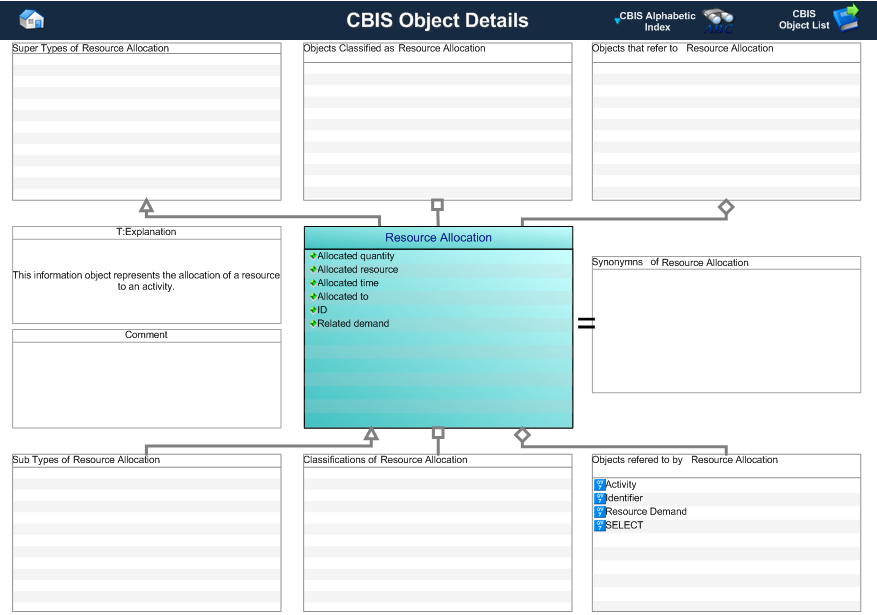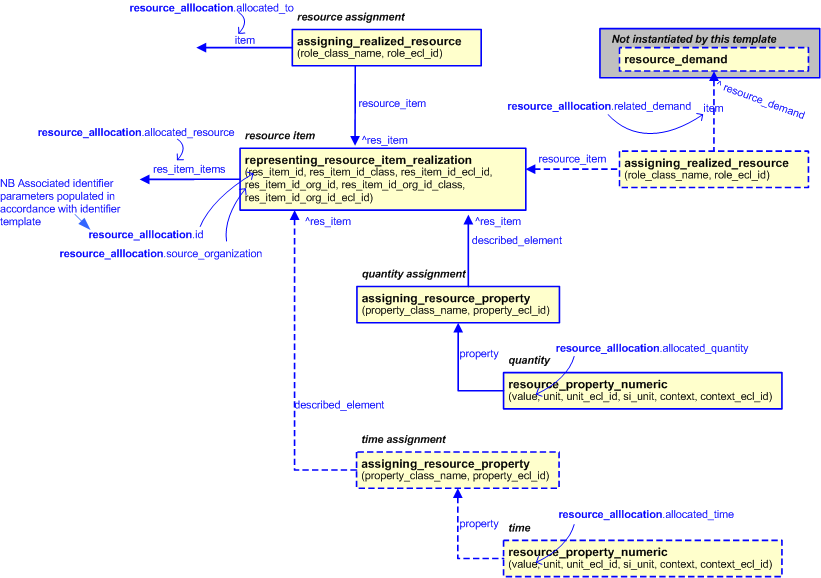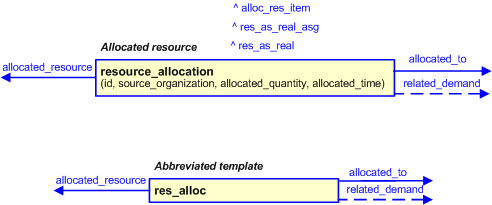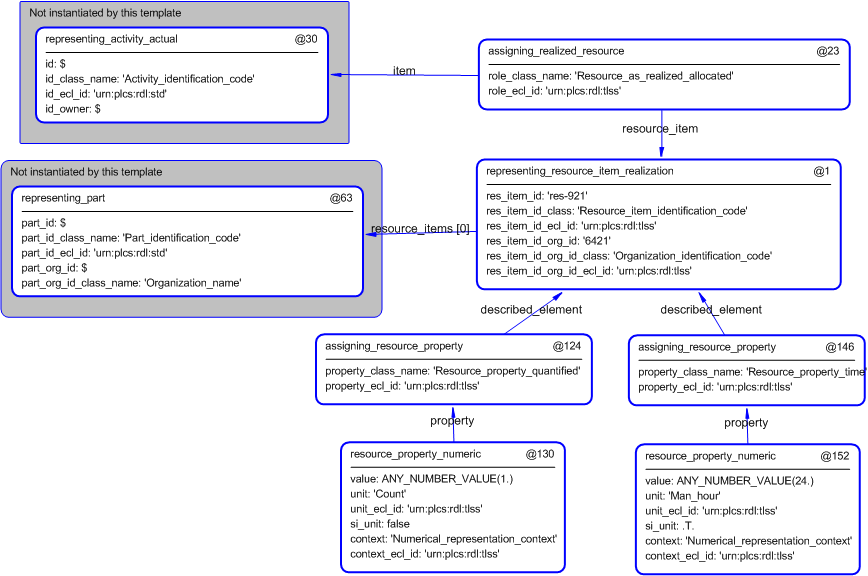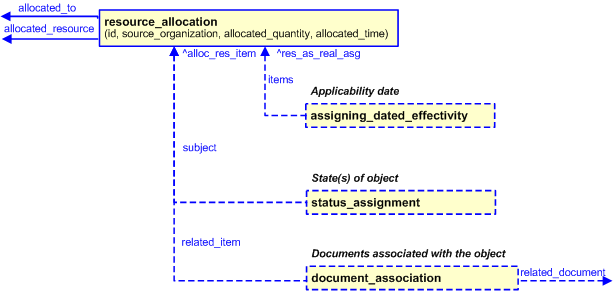Template:— resource_allocation (res_alloc)
Context:— UK_Defence |
Date: 2009/11/09 06:29:39
Revision: 1.5
|
This section specifies the template resource_allocation.
NOTE
The template has been defined in the context of
UK_Defence.
Refer to the business context for details of related templates.
NOTE
An explanation of a template and the associated instantiation path is
provided in the
Template overview
section.
This template describes how to represent the UK_Defence concept of an allocated resource
in terms of PLCS model elements (templates, entities, and reference data)
This information object represents the allocation of a resource to an activity.
This information object represents the allocation of a resource to an activity.
Figure 1 — Graphical Representation for Business Object Resource Allocation
|
Attribute name
|
Attribute description
|
Attribute type
|
Optionality
|
| Allocated quantity |
This is the quantity of the resource that is allocated to the activity. |
Intrinsic |
Mandatory |
| Allocated resource |
This is the reference to the resource that is allocated to the activity. |
SELECT |
Mandatory |
| Allocated time |
This is the time for which the resource is allocated to the activity. |
Intrinsic |
Optional |
| Allocated to |
This is the reference to the activity to which the resource is allocated. |
Activity |
Mandatory |
| ID |
This attribute provides the identification of the Resource Allocation. |
Identifier |
Mandatory |
| Identifier.id |
This is the value of the id attribute of the Identifier applied to the Resource Allocation. |
intrinsic |
Mandatory |
| Identifier.type |
This attribute is the type associated with the id of the Identifier given to the Resource Allocation. This must be one of
the classes provided.
|
Resource_item_identification_code |
Mandatory |
| Identifier.source_organization |
This attribute is the value representing the source organization that provides the id of the Identifier given to the Resource
Allocation. This value is assumed to be a type of Organization_identification_code.
|
Organization_identification_code |
Mandatory |
| Related demand |
This is the reference to the resource demand against which the allocation may be made. |
Relationship to Resource demand |
Optional |
Table 1 — Resource Allocation attribute details
The EXPRESS-G diagram in
Figure
2
shows the templates and EXPRESS entities that are required
to represent the template
"resource_allocation".
The text highlighted in blue shows the template parameters.
Figure 2 — An EXPRESS-G representation of the Information model for resource_allocation
The graphic for the template to be used in other EXPRESS-G diagrams
is shown in Figure
3
below.
Figure 3 — The graphical representation of the resource_allocation template
The following input parameters are defined for this template:
The identifier of the allocated resource.
The organization or information system that created the associated identifier. Alternatively this could be set to /NULL and
when Person or Information System is the source; see Identifier template characterizations.
The quantity of resource allocated to the activity.
The time for which the resource is allocated to the activity.
The time for which the resource is allocated to the activity.
The following classes and their sub-classes can be used:
The resource allocated to the activity.
The activity to which the resource is allocated.
This is the reference to the resource demand against which the allocation may be made.
The following reference parameters are defined for this template:
Allow the
Resource_item
entity instantiated in this path to be referenced when this template is used.
Note: The
Resource_item
entity can be referenced in a template path by:
%^target = $resource_allocation.alloc_res_item%
where
target
is the parameter to which the
Resource_item
is bound.
%^target = $resource_allocation.res_as_real_asg%
%^target = $resource_allocation.res_as_real%
The instantiation path shown below specifies the entities that are to be
instantiated by the template.
A description of templates and the syntax for the instantiation path is
provided in the
Templates Help/Information section.
%^dre =
Decreasing_resource_event%
^dre.name = '/IGNORE'
^dre.resource ->
@allocated_resource/
representing_resource_item_realization(
res_item_id=@id,
res_item_id_class='Resource_item_identification_code',
res_item_id_ecl_id='urn:plcs:rdl:uk_defence',
res_item_id_org_id=@source_organization,
res_item_id_org_id_class='Organization_identification_code',
res_item_id_org_id_ecl_id='urn:plcs:rdl:uk_defence',
res_item_items=^dre)/
-- assign ref parameters %^alloc_res_item = $representing_resource_item_realization.res_item%
/
assigning_realized_resource(
role_class_name='Resource_as_realized_allocated',
role_ecl_id='urn:plcs:rdl_uk_defence',
item=@allocated_to,
resource_item=^alloc_res_item)/
-- assign ref parameters %^res_as_real_asg = $assigning_realized_resource.res_as_rlzd_asg%
%^res_as_real = $assigning_realized_resource.res_as_rlzd%
-- quantity /
assigning_resource_property(
property_class_name='Resource_property_quantified',
property_ecl_id='urn:plcs:rdl:uk_defence',
described_element=^alloc_res_item)/
%^property_qty = $assigning_resource_property.property%
/
resource_property_numeric(
value=@allocated_quantity,
unit='Count',
unit_ecl_id='urn:plcs:rdl:uk_defence',
si_unit='false',
context='Numerical_representation_context',
context_ecl_id='urn:plcs:rdl:uk_defence',
property=^property_qty)/
-- time /
assigning_resource_property(
property_class_name='Resource_property_time',
property_ecl_id='urn:plcs:rdl:uk_defence',
described_element=^alloc_res_item)/
%^property_time = $assigning_resource_property.property%
/
resource_property_numeric(
value=@allocated_time,
unit=@allocated_time_units,
unit_ecl_id='urn:plcs:rdl:uk_defence',
si_unit='true',
context='Numerical_representation_context',
context_ecl_id='urn:plcs:rdl:uk_defence',
property=^property_time)/
-- related demand /
assigning_required_resource(
class_name='Resource_as_realized_demand',
ecl_id='urn:plcs:rdl_uk_defence',
item=@related_demand,
resource_item=^alloc_res_item)/
The following entities are instantiated with attributes as specified:
The instance diagram in Figure
4
shows an example of the EXPRESS entities and templates that are instantiated by the template:
/resource_allocation(id='res-921', source_organization='642l', allocated_resource='#333', allocated_to='#242')/
(an illustration of the consolidated resource_allocation template is shown in
Figure
5 below.)
Figure 4 — Entities instantiated by resource_allocation template
The instance diagram in
Figure
5
shows the graphic symbol for the template that is to be
used in other instance diagrams. The example template is:
/resource_allocation(id='res-921', source_organization='642l', allocated_resource='#333', allocated_to='#242')/
Figure 5 — Instantiation of resource_allocation template
The following section details how the
resource_allocation
template can be optionally characterized by assigning
other constructs to it. These are characterizations commonly
applied to the template. The ISO 10303-239 EXPRESS model may enable
other assignments to the entities instantiated by the template.
The EXPRESS-G diagram in Figure
6
shows the possible characterizations of the template
"resource_allocation".
Figure 6 — Characterizations for resource allocation
The following characterizations may apply:
Characterization Applicability date
NOTE this characterization is optional.
A UK_Defence.resource_allocation
may have effectivities assigned to it, such as an actual or planned effectivity, through the use of the following
templates (or those based upon these):
assigning_dated_effectivity. The following template calls show how these characterizations
might be instantiated.
/assigning_dated_effectivity(start_year='2007', start_month='09', start_day='22', start_hour='09', start_minute='00', start_second='00', start_sense='exact', start_hour_offset='0', role_class_name='Actual_effectivity', role_ecl_id='urn:plcs:rdl:uk_defence', items='@@@@')/
Characterization Status Assignment
NOTE this characterization is optional.
A UK_Defence.resource_allocation
may have one or more status assigned to it, through the use of the following templates (or those based upon these):
UK_Defence.status_assignment.
The following template calls show how these characterizations
might be instantiated.
/status_assignment(assigned_status='', assigned_status_ecl_id='', ID='', ID_type='', ID_organization='', subject='', type='', type_ecl_id='')/
Characterization Document Association
NOTE this characterization is optional.
A UK_Defence.resource_allocation
may have specific documents assigned to it, through the use of the following templates (or those based upon these):
UK_Defence.document_association
, and the associated UK_Defence.document. The following template calls show how these characterizations
might be instantiated.
/document_association(id='', type='', source_organization='', purpose='', related_document='', related_item='')/
